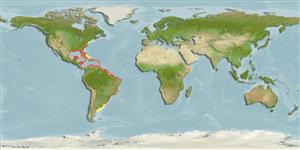>
Eupercaria/misc (Various families in series Eupercaria) >
Gerreidae (Mojarras)
Etymology: Eucinostomus: Greek, eu = good + Greek, kyon = dog + Greek, stoma = mouth (Ref. 45335).
More on authors: Quoy & Gaimard.
Environment: milieu / climate zone / depth range / distribution range
Ökologie
seewasser; süßwasser; brackwasser riff-verbunden; tiefenbereich 0 - 55 m (Ref. 26912). Subtropical; 43°N - 51°S, 98°W - 34°W
Western Atlantic: Massachusetts, USA and Bermuda to Argentina; including the Gulf of Mexico and the Caribbean Sea (Ref. 9626).
Length at first maturity / Size / Gewicht / Alter
Maturity: Lm 11.0 range ? - ? cm
Max length : 25.5 cm TL Männchen/unbestimmt; (Ref. 111768); common length : 15.0 cm TL Männchen/unbestimmt; (Ref. 3722)
Rückenflossenstacheln (insgesamt) : 9; Rückenflossenweichstrahlen (insgesamt) : 10; Afterflossenstacheln: 3; Afterflossenweichstrahlen: 7.
Inhabits shallow waters, being especially abundant over mud bottoms in mangrove-lined lagoons or creeks; larger individuals may also occur on vegetated sand grounds in marine areas. Enters fresh water in limestone regions (Ref. 7251). May occur in aggregations (Ref. 3722). Probably feeds on small benthic invertebrates (Ref. 3722). Marketed fresh but not highly esteemed (Ref. 3722).
Robins, C.R. and G.C. Ray, 1986. A field guide to Atlantic coast fishes of North America. Houghton Mifflin Company, Boston, U.S.A. 354 p. (Ref. 7251)
IUCN Rote Liste Status (Ref. 130435: Version 2024-1)
Bedrohung für Menschen
Harmless
Nutzung durch Menschen
Fischereien: weniger kommerziell; Köder: usually
Tools
Zusatzinformationen
Download XML
Internet Quellen
Estimates based on models
Preferred temperature (Ref.
123201): 22.8 - 28, mean 25.5 °C (based on 504 cells).
Phylogenetic diversity index (Ref.
82804): PD
50 = 0.5010 [Uniqueness, from 0.5 = low to 2.0 = high].
Bayesian length-weight: a=0.01122 (0.00947 - 0.01330), b=3.08 (3.04 - 3.12), in cm total length, based on LWR estimates for this species (Ref.
93245).
Trophic level (Ref.
69278): 2.7 ±0.1 se; based on diet studies.
Widerstandsfähigkeit (Ref.
120179): mittel, Verdopplung der Population dauert 1,4 - 4,4 Jahre. (K=0.3).
Fishing Vulnerability (Ref.
59153): Low to moderate vulnerability (32 of 100).
Nutrients (Ref.
124155): Calcium = 41 [15, 82] mg/100g; Iron = 0.587 [0.266, 1.134] mg/100g; Protein = 19.8 [17.8, 21.8] %; Omega3 = 0.224 [0.114, 0.430] g/100g; Selenium = 13.7 [6.2, 27.5] μg/100g; VitaminA = 49.3 [12.6, 191.8] μg/100g; Zinc = 1.22 [0.77, 1.92] mg/100g (wet weight);
